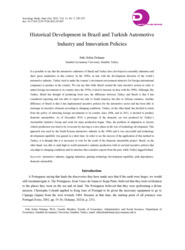Historical Development in Brazil and Turkish Automotive Industry and Innovation Policies
-
Yazar
Sıtkı Selim Dolanay
-
Tür
Makale
- Yayın Yılı 2021
- DOI 10.17265/2159-5526/2021.05.005
-
Yayıncı
David Publishing
- Tek Biçim Adres https://hdl.handle.net/20.500.14081/2030
-
Konu Başlıkları
Automotive industry
Lagging industries
Gaining technology development capability
Path dependency
Domestic automobile
It is possible to say that the automotive industries of Brazil and Turkey have developed as assembly industries and show great similarities in this context. In the 1980s, in line with the development direction of the world’s automotive industry, Turkey tried to make the country’s investment environment attractive for foreign international companies to produce in the country. We can say that while Brazil created the state incentive system in order to attract foreign investments to its country since the 1950s, it tried to increase its dose with the 1990s. Although, like Turkey, Brazil has thought of producing local cars, the difference between Turkey and Brazil is that it has considered exporting and was able to export not only to South America, but also to African countries. Another difference of Brazil is that it has implemented incentive policies for the automotive sector and has been able to rearrange its incentive elements according to changing conditions. Turkey, on the other hand, has decided to return from the policy of attracting foreign investments to its country since 2006, and in 2011, it decided to produce domestic automobiles. As of December 2019, a prototype of the domestic car was produced by Turkey’s Automobile Initiative Group and work for mass production began. Thus, the problem of adaptation to electric vehicle production was tried to be overcome by moving to a new phase in the way of technology development. This approach was used by the South Korean automotive industry in the 1980s and it was successful and technology development capability was gained in a short time. In order to see the success of the application of this method in Turkey, it is thought that it is necessary to wait for the result of the domestic automobile project. Brazil, on the other hand, was able to rank high in world automotive industry production with its sectoral incentive policies that can adapt to changing conditions and its structure that considers exports from the past, while Turkey lagged behind.
-
Koleksiyonlar
Fakülteler
İktisadi İdari ve Sosyal Bilimler Fakültesi


 Tam Metin
Tam Metin

